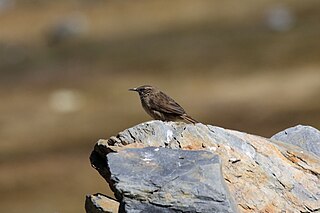
The Cipo canastero is a Near Threatened species of bird in the Furnariinae subfamily of the ovenbird family Furnariidae. It is endemic to Brazil.

The common miner is a passerine bird in the subfamily Sclerurinae, the leaftossers and miners, of the ovenbird family Furnariidae. It is found in Argentina, Bolivia, Brazil, Chile, Peru, and Uruguay.

Canasteros and thistletails are small passerine birds of South America belonging to the genus Asthenes. The name "canastero" comes from Spanish and means "basket-maker", referring to the large, domed nests these species make of sticks or grass. They inhabit shrublands and grasslands in temperate climates from the lowlands to the highlands. They feed on insects and other invertebrates gleaned from the ground or the low vegetation.

Berlepsch's canastero is a Near Threatened species bird in the Furnariinae subfamily of the ovenbird family Furnariidae. It is endemic to Bolivia.

The rusty-vented canastero, or creamy-breasted canastero, is a species of bird in the Furnariinae subfamily of the ovenbird family Furnariidae. It is found in Argentina and Bolivia.

The many-striped canastero is a species of passerine bird in the Furnariinae subfamily of the ovenbird family Furnariidae. It is found in Colombia, Ecuador, and Peru.

Hudson's canastero is a Near Threatened species of bird in the Furnariinae subfamily of the ovenbird family Furnariidae. It is found in Argentina, Brazil, and Uruguay.

The streak-throated canastero is a species of bird in the Furnariinae subfamily of the ovenbird family Furnariidae. It is found in Bolivia and Peru.

The scribble-tailed canastero is a species of bird in the Furnariinae subfamily of the ovenbird family Furnariidae. It is found in Argentina, Bolivia, and Peru.

The cordilleran canastero is a species of bird in the Furnariinae subfamily of the ovenbird family Furnariidae. It is found in Argentina, Bolivia, Chile, and Peru.

The sharp-billed canastero or lesser canastero is a species of bird in the Furnariinae subfamily of the ovenbird family Furnariidae. It is found in Argentina, Bolivia, Chile, Paraguay, and Uruguay, and has also occured as a vagrant in Brazil.

The Junin canastero is a species of bird in the Furnariinae subfamily of the ovenbird family Furnariidae. It is endemic to Peru.

The buff-winged cinclodes is a species of bird in the Furnariinae subfamily of the ovenbird family Furnariidae. It is found in Argentina, Brazil, Chile, Paraguay, Uruguay and as a vagrant on the Falkland Islands.

The grey-flanked cinclodes, formerly known as Oustalet's cinclodes, is a species of bird in the Furnariinae subfamily of the ovenbird family Furnariidae. It is found in Argentina and Chile.

The dark-bellied cinclodes is a species of bird in the Furnariinae subfamily of the ovenbird family Furnariidae. It is found in Argentina and Chile.

The short-billed miner is a species of bird in the subfamily Sclerurinae, the leaftossers and miners, of the ovenbird family Furnariidae. It is found in Argentina and Chile.

The spot-breasted thornbird is a species of bird in the Furnariinae subfamily of the ovenbird family Furnariidae. It is found in Argentina and Boliva.

The greater thornbird is a species of bird in the Furnariinae subfamily of the ovenbird family Furnariidae. It is found in Argentina, Bolivia, Brazil, Paraguay, and Uruguay.

The dark-winged canastero, or Arequipa canastero, is a species of bird in the Furnariinae subfamily of the ovenbird family Furnariidae. It is found in Bolivia, Chile, and Peru.

The pale-tailed canastero, is a species of bird in the Furnariinae subfamily of the ovenbird family Furnariidae. It is endemic to Peru.






















